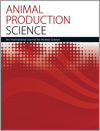
Animal Production Science
Volume 63 Number 12 2023
AN23140Livestock preference and feeding value as key determinants for forage improvement – why not ask the consumers?
This review presents a new model for a multidisciplinary approach to development of modern forage cultivars for the mixed farming zones of Australia. This involves farmer input and the measurement of key traits that drive profitability of livestock such as feeding and nutritive value much earlier in the development pipeline.
AN23140 Abstract | AN23140 Full Text | AN23140PDF (859 KB) Open Access Article
Although mating of ewe lambs increases farm profitability and can reduce environmental impact of meat production, uptake is low owing to low reproductive success. We showed that significant embryo loss, a key driver of poor reproductive success, occurred prior to Day 3 of pregnancy in peripubertal ewe lambs. We identified quality of the oocyte and oviduct as key to improving reproductive success in peripubertal ewe lambs and thus facilitating uptake of mating of ewe lambs.
AN22417 Abstract | AN22417 Full Text | AN22417PDF (1.3 MB) Open Access Article
AN22058Effect of tannins and kafirins on the nitrogen and energy balance and performance of pigs
 , Iris Elisa Ávila Árres, José Guadalupe Gómez-Soto
, Iris Elisa Ávila Árres, José Guadalupe Gómez-Soto  , Konisgmar Escobar García
, Konisgmar Escobar García  , Ericka Ramírez Rodríguez
, Ericka Ramírez Rodríguez  and Gerardo Mariscal-Landín
and Gerardo Mariscal-Landín 
Tannins are blamed for negatively affecting nutritive value of sorghum; however, information on effects of kafirins in pigs is scarce. In a performance trial in pigs, we found that tannin content negatively affected daily feed intake and feed efficiency. High kafirin content in sorghum worsened the negative effect on daily feed intake and liveweight gain, thence final weight.
There are few studies on the application of bamboo resources in broilers. This study found that adding micronised bamboo powder at 1% to replace equivalent maize can improve intestinal development and increase the content of bacteria that promote fatty acid metabolism and fibre degradation in broilers. Bamboo can be used as beneficial fibre for broilers as a means to alleviate global shortage of feed materials.
AN22363 Abstract | AN22363 Full Text | AN22363PDF (2.3 MB) Open Access Article
AN22241Effects of dietary conjugated linoleic acid in broiler breeders and egg storage time on the fatty acid profile, lipid oxidation and internal egg quality
 , Cristiane B. de Lima, Frederico L. da Silva, Márcio A. Mendonça, Candice B. G. S. Tanure, José Henrique Stringhini
, Cristiane B. de Lima, Frederico L. da Silva, Márcio A. Mendonça, Candice B. G. S. Tanure, José Henrique Stringhini  and Aline M. C. Racanicci
and Aline M. C. Racanicci 
Conjugated linoleic acid (CLA) is a group of positional geometric isomers of linoleic acid mainly known for its antioxidant activity, but when fed to broiler breeders, despite resultant modifications on the size and composition of the eggs, yolk and albumen, CLA can be an alternative for preservation of the internal quality of fertile eggs during storage and to increase the quality of day-old chicks.
AN22241 Abstract | AN22241 Full Text | AN22241PDF (1 MB) Open Access Article
AN22302Time spent feeding as an early indicator of metritis in postpartum dairy cows: systematic review and meta-analysis
The early identification of sick cows is critical for dairy farms; then, cows with metritis and subclinical ketosis (SCK) in the postpartum reduce time spent feeding in the prepartum and postpartum periods? Metritis decreases this feeding behaviour in the both periods and is influenced by the number of daily milkings. The time spent feeding is a good predictor for early detection of metritis, but its use is unclear for SCK.
AN22223Pre-established anthelmintic protocols in horses: low efficacy and unnecessary treatments highlight the need for strategic deworming
 , Fernando Jahn Bessa, Giuliano P. de Barros and Patrizia Ana Bricarello
, Fernando Jahn Bessa, Giuliano P. de Barros and Patrizia Ana Bricarello
The pre-established deworming protocol had reduced efficacy and the anthelmintics treatments were considered likely to be unnecessary in most horses. This study highlighted not only the issue of the indiscriminate use of anthelmintics regarding parasitic resistance, but also the exposure of horses to unnecessary treatments. Such widespread use is a costly waste of resources and further reinforces the need for strategic deworming in horses.
Extensive grasslands provide manifold ecosystem services, but nutrient export with animal-source products as a consequence of grazing is expected to influence pasture productivity in the long term. In a 16-year grazing trial on extensive grassland without fertiliser input, a reduction in pasture productivity over time was found in three different stocking intensities. Thus, a more economically oriented extensive grazing management will likely not reduce pasture performance more than is more lenient grazing.
AN22409The effects of Alnus viridis encroachment in mountain pastures on the growth performance, carcass and meat quality of Dexter cattle and Engadine sheep
 , A. Lüscher, K. Giller
, A. Lüscher, K. Giller  , P. Silacci, J. Messadène-Chelali, J. Berard
, P. Silacci, J. Messadène-Chelali, J. Berard  and M. Kreuzer
and M. Kreuzer
Alnus viridis (green alder) encroaches on many mountain pastures. As these areas are still grazed, we tested the performance and carcass and meat quality of Dexter cattle and Engadine sheep under different encroachment levels. The Dexter cattle were slightly less efficient in forage valorisation, but both robust animal species produced satisfactory carcass and meat quality regardless of the shrub encroachment levels. Extensive grazing of A. viridis-encroached pastures is therefore possible without restrictions on meat production of a unique quality.
AN22409 Abstract | AN22409 Full Text | AN22409PDF (1.9 MB) | AN22409Supplementary Material (1.5 MB) Open Access Article



